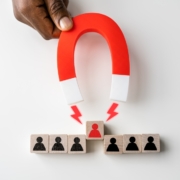Key B2B Ecommerce Statistics Every CEO Should Know When It Comes to Marketing
Imagine a B2B salesman without a phone. It would be like a doctor without a stethoscope or an artist without a paintbrush.
The telephone has played such a significant part in B2B sales that it has nearly become synonymous with the whole industry. Prospecting, qualifying, nurturing, and, on occasion, pitching and closing are all done using it.
However, evidence shows that its time in the spotlight may be coming to an end. According to McKinsey research, 77 percent of B2B decision-makers prefer videoconferencing over talking on the phone with vendors.
It’s perhaps a bit early to be permanently disconnecting your phone line, however, with 53 percent of marketers reporting greater ROI from inbound engagement (vs. just 16% for outbound), sales teams are spending more time talking to warm leads and less time talking to cold prospects.
SEO isn’t a choice
Consider this statistic: “Organic online search clicks outweigh sponsored web search clicks by roughly 12 to 1” When someone searches the web and discovers some of your material as a consequence of that search, you get organic web search clicks (on the first page normally). This isn’t a sponsored search. They haven’t found an ad you’ve purchased for that phrase. This indicates that, on average, more visitors (12 to 1) are discovering connections to existing material on a company’s website.
Buyers Stats
Below are some interesting buyer statistics that you should be aware of, especially as we transition into the digital space more and more.
- Before contacting a salesperson, 70 percent of buyers clearly identify their demands on their own, and 44 percent pinpoint solutions before contacting a seller.
- When it comes to choosing which firm to do business with, 70% of B2B buyers say corporate reputation is the most important aspect. B2B purchasers are most likely to share beneficial material through email, with 72 percent doing so.
- 34 percent of B2B buyers believe features are the most important factor in their buying choices, followed by price (27%), and brand (39%).
- 65.2 percent of B2B buyers felt that addressing their problems with salespeople was beneficial.
- At the start of a sales interaction, 45.6 percent of B2B customers want to hear fresh ideas. Online content has a moderate to substantial impact on purchase choices for nine out of ten B2B customers.
- Social media is used by 84 percent of CEOs and VPs to make purchase choices.
- Rather than advertising, 80 percent of corporate decision-makers prefer to obtain company information via a series of articles.
- The buyer’s journey is now completed online in 67 percent of cases.
- 63 percent of customers need to hear a company’s claim three to five times before believing it.
- Before actively interacting with sales, B2B buyers are generally 57 percent of the way to a purchase decision. This emphasizes the necessity of marketing paving the way for customers to learn about and connect with your business at every stage of the journey.
- Consumers believe that marketing wastes time by forcing prospects to pay attention rather than making them want to pay attention.
- B2B buyers use social media to find information in 55 percent of the total cases.
- Most purchasing decisions are made by an average of seven persons in a company with 100 to 500 workers.
- Most purchasing decisions are made by an average of seven persons in a company with 100 to 500 workers.
- Mobile applications and marketplaces like Amazon are on the increase, indicating that B2B merchants are swiftly moving away from immature ecommerce channel testing and toward comprehensive omni-channel sales strategies.
- Credit cards continue to be the most popular payment method for online purchases (94 percent), however checks, terms, and purchase orders are also important for B2B purchasers (51 percent , 53 percent , 50 percent , respectively.)
- Mobile wallets such as Amazon Pay and Apple Pay are gaining popularity (26 percent ).
- According to research, increased personalization is a significant aspect for B2B customers when looking for online suppliers with which to form connections, with consumers paying 48 percent more when their experience is individualized.
Marketing Stats
By 2025, the market for customer experience management is predicted to increase, reaching $14.9 billion. B2B clients want the same high-quality experience as B2C customers, and businesses can’t deny it.
Brands must use consumer data, AI, and machine learning to completely customize B2B purchasing experiences. Many B2Bs may find that their employee experience is an excellent place to start when creating a distinctive experience. Many workers today work from home, and providing them with an online experience would empower and inspire them to give better customer service.
Most B2B companies would agree that marketing is critical to their success and that a strong marketing effort, much like in B2C, may help bring their brand in front of more people. Help to convert those individuals into leads. And, as a result, more sales. However, since a quarter of B2B companies spend just 5 percent of their overall expenditure on marketing, the belief is not inline with the budget and despite the fact that marketing generates a steady supply of leads, just 8% of respondents claimed they dedicated more than 15% of their resources to it.
Nearly half of B2B companies stated they want to increase their content expenditure in the next year. Only 4 percent of respondents want to cut down on their expenditures. Which only goes to demonstrate that in the B2B industry, content marketing still has a high potential ROI.
B2B marketers spend 50 percent of their time developing content to raise brand recognition and interest (Content Marketing Institute.) It’s tempting to believe that B2B content should be dull and formal. However, the fact is that B2B purchasers are still people. Reading material from a brand, like reading information from any other person, may help decision-makers get to know, like, and trust you better. Knowing what content to deliver and when is the key to getting in front of those key decision makers.
Being able to map out a customer’s full eCommerce journey to anticipate every step of the way is imperative in order to achieve bottom-line outcomes. Learn more about Friend of Commerce’s marketing suite and how we can help you see results quickly.
Want to watch our video on this topic? Watch now.
Ready to get started? Tell us a little bit about your company, the challenges you are looking to solve, and we’ll be in touch right away. Follow our blog and subscribe to our communications for more tips and trends on digital transformation and B2B commerce.
Photo courtesy of: FreePik










